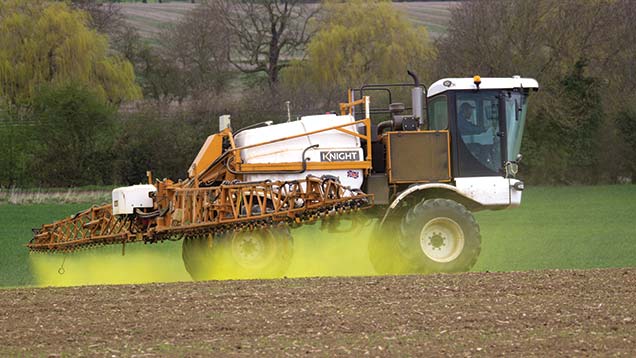Tips to help decimate weeds in your spring cropping
 (c) Tim Scrivener
(c) Tim Scrivener Pre-emergence herbicides are essential in spring crops, but drier soils that limit residual activity and the loss of one option for spring wheat is set to make weed control more of a challenge this season.
Soils getting warmer and drier will limit the efficacy of herbicides that are dependent on moisture for best results, explains Dick Neale, technical manager with Hutchinsons, who highlights that active ingredients such as pendimethalin and prosulfocarb will struggle in dry soils.
See also: Tips on getting the most from your spring cropping
“Whereas the residuals tend to give better results as the season progresses in autumn-drilled crops, the opposite is true in spring crops.
“It’s more of an issue in crops that are drilled later, such as peas, but it is a consideration for cereal crops too,” he says.
Actives
- Atlantis – iodosulfuron + mesosulfuron
- Aramo – tepraloxydim
- Avadex – tri-allate
- Axial – pinoxaden
- Butisan – metazachlor
- Centium – clomazone
- Crystal – flufenacet + pendimethalin
- Defy – prosulfocarb
- Laser – cycloxydim
- Liberator – diflufenican + flufenacet
- Novall – metazachlor + quinmerac
- Springbok – dimethenamid + metazachlor
- Stomp Aqua – pendimethalin
- Topik – clodinafop
By far the biggest choice of grassweed herbicides can be found for spring barley, he adds. “And of course it is a very competitive crop, which helps with weed control anyway. So there should be less need for herbicide programmes, providing cultural control measures have been carried out well.”
Independent agronomist Andrew Cotton agrees, although he points out that the Extension of Authorisation for Minor Use (EAMU) for Defy on spring wheat hasn’t come through for 2015.
“That’s a change from last year. Otherwise, the choices remain the same for grassweeds.”
Barley options
The pre-emergence options for spring barley include Stomp Aqua and Avadex, he reveals. “Then we have the flufenacet-based products – Liberator can be applied at 0.3 litres/ha up to GS24 and Crystal at 2 litres/ha up to GS23.
“In addition, there’s DFF at 0.125 litres/ha, which gives best results when it is applied pre-emergence, and Defy at 3 litres/ha, which can be applied up to GS13.
“Finally, there’s Axial, which can be applied up to 0.6 litres/ha until GS41. Results from that will depend on the resistance status of your blackgrass.”
Last year, he used Avadex followed by a Liberator/Defy mix, which gave good results, he recalls.
Wheat concern
Spring wheat has fewer herbicide options, as flufenacet-based products can’t be used. “Given the increasing importance of spring wheat, we urgently need clearance for Liberator and Crystal,” says Mr Cotton.
The pre-emergence choices include Stomp Aqua and Avadex, used at the same rates as for spring barley, although Stomp Aqua can also be used early post-emergence, says Mr Cotton. “Avadex came through last year, which was a good addition.”
Post-emergence herbicides that can be used on spring wheat include Axial and Topik, both up to GS41, and Atlantis at 0.4kg/ha. “But Atlantis can only be applied to crops sown before 1 February in the year of harvest,” he advises.
Oats and OSR
Spring oats only have DFF, which can be applied pre- or early post-emergence at a rate of 0.2 litres/ha.
“However, oats do most of the job for you when it comes to grassweeds. Providing you put plenty of seed on, they will have a smothering effect. So the lack of approved herbicides isn’t necessarily a problem.”
Spring oilseed rape, which can be sown late, allows multiple blackgrass flushes to have taken place and been dealt with, says Mr Cotton.
“It is sensible to avoid low seed rates, so a hybrid variety may not be suitable where grassweeds are an issue.”
Pre-emergence options include Butisan and Centium, while Laser can be applied post-emergence. “The EAMU for Novall/Springbok hasn’t been renewed since 2013. It’s a shame – we need it.”
In spring beans, the options include Stomp Aqua and Centium, as well as Aramo and Laser. “The problem in spring beans is where you have gaps in crops. Blackgrass fills them in.”
What about broad-leaved weeds?
Pre-emergence herbicide use in spring cereals tends to be driven by the grassweed risk, but it’s a different story with pulse crops, says Dick Neale, technical manager at distribution group Hutchinsons.
In spring beans, the post-emergence choices are limited to bentazone – which is expensive and very weather dependent, he explains. “So pre-emergence residual materials are important and should be used to bring in broad-leaved weeds such as volunteer oilseed rape and brassica weeds.”
Various pendimethalin formulations as well as actives such as imazamox, linuron and clomazone can be used, he says.
Peas are drilled later, limiting the efficacy residuals can bring, but the only post-emergence option is bentazone, he adds.
“So again, there’s a need to make best use of pre-emergence materials and hope for the right conditions.”

